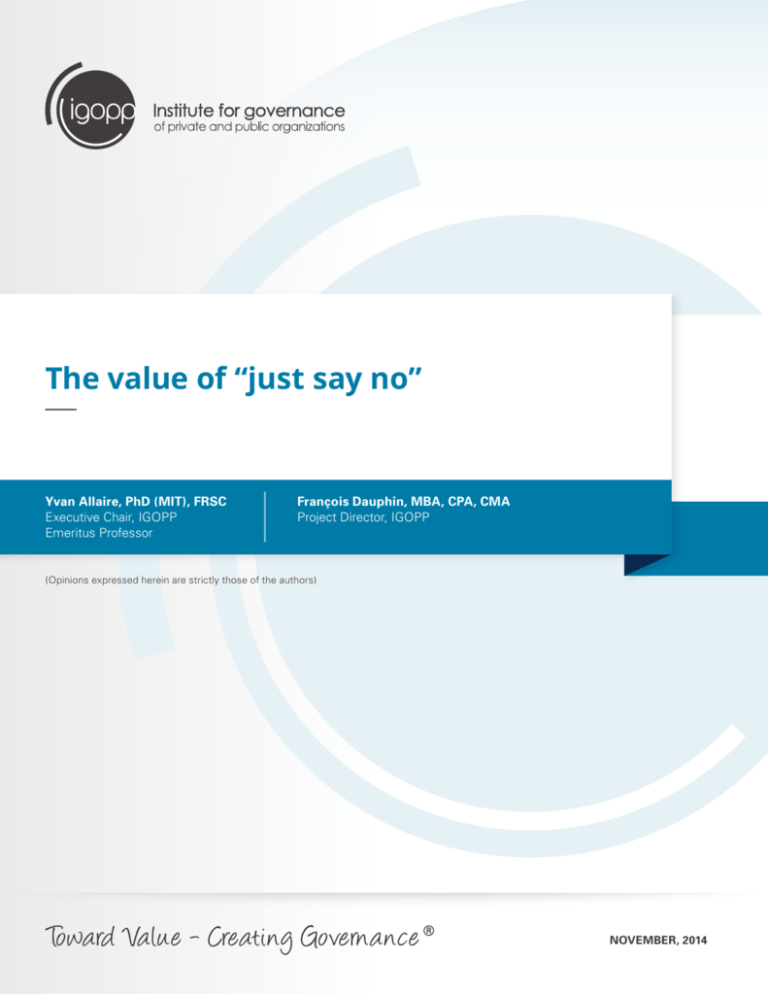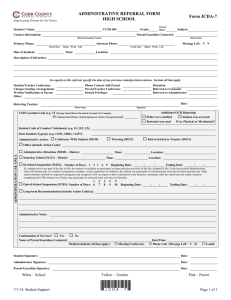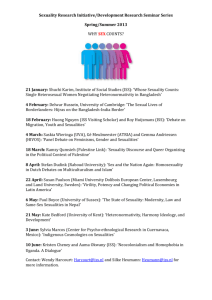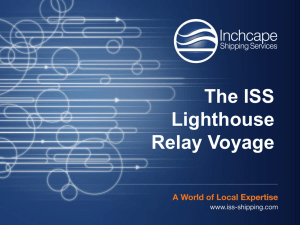
The value of “just say no”
_
Yvan Allaire, PhD (MIT), FRSC
Executive Chair, IGOPP
Emeritus Professor
François Dauphin, MBA, CPA, CMA
Project Director, IGOPP
(Opinions expressed herein are strictly those of the authors)
Toward Value - Creating Governance ®
NOVEMBER, 2014
Unfortunately, the ISS note does not support such a blanket statement. Already, several commentators,
notably Sabastian V. Niles of legal firm Wachtell, Lipton, Rosen & Katz (see – “Shareholder Returns
of Hostile Takeovers”), have been sharply critical of the ISS paper: the very small sample size, the
inclusion of two target companies with miniscule stock market value, the exclusion of a case where
the shareholders eventually accepted a tender offer (thus not qualifying as a “No” vote) but only
after management elicited a very large increase in bid price.
Our take on the ISS paper will highlight other debatable aspects of their analysis.
1. T
he ISS note is based on a very small sample of companies from vastly different industries
(industrial gases, convenience stores, internet software, power production, etc.) and on
takeover events scattered over four years. To increase their sample size, they include two
micro-cap companies that should be removed from the analysis, as we shall do in the
rest of this piece: Onvia (market cap-$36 million) and Pulse Electronics (market cap-$250
million). As per the ISS note, the bold numbers of Table 1a claim to represent the total
market performance of the companies that have rejected the attempted takeover since
the time of the “No” vote, compared to an S&P 500 index fund and “peer group” median
performance.
Table 1a
Absolute Total
Shareholder
Return Since
Contest
Comparison
with S&P
500 Index
Performance
Comparison
with Peer
Median
Performance
Years Since
Contested
Meeting
Market Value
on date of
Shareholder
Vote ($M)
NRG Energy
18.7
-107.4
-99.1
5.3
7,915
AirGas
82.1
-5.2
20.8
4.1
5,478
Casey's
88.7
1.4
-91.8
4.1
1,962
Illumina
304.4
257.2
246.9
2.5
6,286
Onvia
10.4
-44.8
-65.1
2.4
36
Pulse Electronics
-98.4
-153.5
-153
3.4
250
Average
67.7
-8.7
-23.5
3.6
3,655
Median
50.4
-25.0
-78.4
3.8
3,720
Source: Data from ISS, “The IRR of ‘No’”
02
The value of “just say no”
On October 22nd 2014, ISS published a note on the financial consequences for shareholders to vote
“NO” to a proposed takeover. The ISS note, and its conclusion, comes at a propitious time for the
Valeant cum Pershing Square attempt to take over Allergan. The shareholders of Allergan, who may
get to vote on this takeover on December 18th, are now “informed” that those shareholders who
voted “No” to a proposed takeover of their company would have been better off financially, had
they agreed to the takeover. “For those [proposed takeovers] which do go all the way to a vote yet
remain independent, however, the abysmal subsequent returns relative to shareholders’ next best
alternatives suggest something in the process has gone awry”. (ISS, The IRR of NO, page 3)
Table 1b
Absolute Total
Shareholder
Return Since
Contest
Comparison
with S&P
500 Index
Performance
Comparison
with Peer
Median
Performance
Years Since
Contested
Meeting
Market Value
on date of
Shareholder
Vote ($M)
NRG Energy
18.7
-107.4
-99.1
5.3
7,915
AirGas
82.1
-5.2
20.8
4.1
5,478
Casey's
88.7
1.4
-91.8
4.1
1,962
Illumina
304.4
257.2
246.9
2.5
6,286
Average
123.5
36.5
19.2
4.0
5,410
Median
84.5
-1.9
-35.5
4.1
5,882
Source: Data from ISS, “The IRR of ‘No’”
Then, Table 2 shows the sensitivity of this whole exercise to small variations in the dates
selected for the analysis. Hence, choosing between October 20th and October 21st for the
final stock market value makes a significant difference in performance scores. (The ISS note
refers to October 20th in the text (see pages 1 and 2) but to October 21st in various tables)
By October 31st, a mere 10 days later, the picture had changed substantially.
Table 2
Total shareholder return, from the day before the vote to…
October 20, 2014
October 21, 2014
October 31, 2014
NRG Energy†
25.5%
26.3%
32.9%*
AirGas
83.6%
88.7%
84.9%
Casey's
87.8%
87.9%
100.9%*
Illumina
273.8%
308.1%
337.7%
*The dividend paid by NRG and Casey’s on October 30, 2014 was considered in the adjusted price at closing on the day before
the contested meeting for the calculation of the total shareholder return of October 31, 2014.
Source for stock price data: Yahoo! Finance
We computed a vast array of permutations (average daily price, closing and opening prices, etc.) and we were unablee to replicate
the 18.7% shown in the ISS analysis.
†
03
The value of “just say no”
Table 1b presents the same results but after excluding the two micro-cap companies.
The picture is very different. Now, the four significant cases of takeover rejection produce
a market performance equal to the S&P 500 and much closer to a supposed peer group
(about which, much to come below). Note that ISS chose to present and use only the
median results, never the average, a choice that serves well their thesis in this case.
ISS seems surprised that in the immediate period after a “No” vote, the company’s stock
price drops. But, rather obviously, as the bid price included a control premium and market
price gravitated towards the bid price, a negative vote would immediately provoke a drop
in price. The important point here for an investor (and the courts) has to be the long-term
performance of the stock relative to the price before the hostile takeover attempt became
public.
Table 3 shows the significance of this adjustment. Three out of the four companies now
beat the S&P 500 index fund by a wide margin. This result tells investors that rejection of
the bid was entirely justified as these companies (at least three of them) produced returns
that surpassed the (unusually hot) S&P index.
Table 3
Total Shareholder
Return since day of
the vote (ISS)
Difference with
S&P 500 Index
(ISS)
Total Shareholder
Return Since the
Day Before the
Announcement of
Hostile Bid
NRG Energy
18.7
-107.4
53.8
-82.6
AirGas
82.1
-5.2
184.2
83.5
Casey's
88.7
1.4
156.1
76.9
Illumina
304.4
257.2
376.4
320.3
Difference with
S&P 500 Index
Source for stock price data: Yahoo! Finance. All returns calculated with the closing prices of October 21, 2014.
Indeed, as shown in Table 4, the annual compounded returns, since the day before the
hostile intentions were made public, confirm this relationship.
Table 4
Date of
announcement
Compounded Annual
Shareholder Return
(since the Day Before
the Announcement
of Hostile Bid)
Compounded
Annual Return,
S&P 500 Index
(same period)
Difference
NRG Energy
2008/10/19
7.4
15.4
-8.0
AirGas
2010/02/05
24.8
15.9
8.9
Casey's
2010/04/09
23.0
13.7
9.3
Illumina
2012/01/25
76.8
17.7
59.1
Source for stock price data: Yahoo! Finance. All returns calculated with the closing prices of October 21, 2014.
04
The value of “just say no”
2. W
hat is the stock market performance of these four companies from the day before
hostile intentions were made public, up to October 21st 2014?
Let’s build a portfolio, as an investor might, of “No” companies, investing $1,000 in the
first company in 2008 (NRG) from the day before the announcement of the hostile bid. The
portfolio is then re-evaluated to integrate new “No” companies as the events occur. The
adjustment consists of allocating the value of the portfolio across companies at the time
a new event occurs so as to reflect the new market-weighted capitalization of all “NO”
companies at that point of time.
Table 5 presents the result of this operation. The weighted portfolio of NO companies
beat handily the performance of the S&P 500 index.
Table 5
Initial
Investment
(Oct 20, 2008)
Portfolio Market
Value
(Oct 21, 2014)
Total Investment
Period (Years)
Portfolio
CAGR
S&P 500 Index
Fund CAGR
$1,000
$3,535.21
6.0055
23.40%
15.40%
Source for stock price data: Yahoo! Finance.
4. T
he ISS paper contends that the performance of these “No” companies is even worse
when compared to a «median peer group» company. We examine one particular
instance we happen to know well as the bidding company is Canadian (Casey’s, a chain
of convenience stores) to show why this sort of comparison is highly questionable. The
following companies (Table 6) were selected by ISS for the purpose of assessing Casey’s
performance:
Table 6
Market value (M$) on
September 22nd 2010
Compounded annual
shareholder return
2,181
16.7%
Susser Holdings
233
55.2%
Pantry Inc.
515
1.6%
Travelcenters of America
58
28.9%
Alimentation Couche-Tard
6,884
49.0%
Casey’s
Source for stock price data: Yahoo! Finance. All returns calculated with the closing prices of October 21, 2014.
05
The value of “just say no”
3. T
he ISS paper compares the stock market performance of each of these four companies
to the S&P 500 index; but the real test here would be to compare the market weighted
performance of these four companies with the (obviously) market weighted S&P 500
index. (Note that including the two small companies eliminated from analysis would not
change appreciably the results of this test).
The graph on page 7 of the ISS paper which supports this 92% in additional return clearly
maps out the stock performance of the median company in terms of performance. As
Table 6 above shows, this median company happens to be Travelcenters of America, a
truck stop servicer. Here’s the profile of the company on Yahoo Finance:
TravelCenters of America LLC operates and franchises travel centers primarily along the
United States interstate highway system. It offers diesel fuel and gasoline; operates full
service restaurants under the Iron Skillet and Country Pride brands; and operates quick
serve restaurants under the Arby’s, Burger King, Dunkin’ Donuts, Pizza Hut, Popeye’s
Chicken & Biscuits, Starbuck’s Coffee, Subway, and Taco Bell brands. The company also
operates truck repair and maintenance facilities, which offer maintenance and emergency
repair and road services ranging from basic services, such as oil changes and tire repair
to specialty services, including diagnostics and repair of air conditioning, air brakes, and
electrical systems…
That company is as much a “peer” to Casey’s as, say, Starbuck’s. But, in the view of ISS,
the shareholders of Casey’s should have sold their shares and invested the $2.2 billion
proceeds in a company with a market cap at the time of $58 million!! That would have
produced a 92% increase in return.
5. F
inally, we introduce a concept from Investment 101, the risk-return relationship. We show
how the analysis leads to different conclusions if we introduce volatility in the assessment,
by computing, for instance, the Sharpe ratio1 for the different companies in Casey’s
supposed peer group. Tables 7 and 8 present instructive information.
Whether the returns are calculated, as we contend is more appropriate, from the day
before hostile takeover intentions are made public (Table 6) or, as ISS does, from the
day before the vote (Table 7), the results give the same message: the worst company
performance is posted by The Pantry, followed by Travelcenters of America. Actually, on
the basis of risk-return, Casey’s is the median company.
1 T he Sharpe ratio is simply the rate of return of a stock (or a portfolio of stocks) minus the risk-free rate of interest, divided by the standard deviation
of the stock’s price (a measure of volatility). The higher the ratio, the better investors are compensated for the level of risk (or volatility) they have
incurred.
06
The value of “just say no”
The ISS paper then suggests that the performance of Casey’s since the “NO” vote be
compared with the performance of these “close” peers. By investing the proceeds of the
sale of their Casey shares (N.B. without any consideration of capital gain tax) in a group of
peers, ISS claims they would have realized, at the median, an additional 92% between
September 2010 and October 21st 2014. Impressive? No, misleading.
Sharpe Ratio, for the period from day before announcement of hostile bid
to October 21, 2014
Expected return: real compounded annual shareholder return
Compounded Annual
Shareholder Return
minus risk-free rate
(2.33%)
Annualized Standard
Deviation
Sharpe Ratio
Casey’s
20.7%
24.8%
0.83
Susser Holdings*
61.6%
36.1%
1.71
Pantry Inc.
9.3%
41.1%
0.22
Travelcenters of America
18.5%
76.9%
0.24
Alimentation Couche-Tard
49.2%
24.5%
2.01
From April 8, 2010 to
October 21, 2014
Source for stock price data: Yahoo! Finance.
*to August 29 th 2014 for Susser Holdings
Table 8
Sharpe Ratio, for the period from the day before the vote to October 21, 2014
Expected return: real compounded annual shareholder return
Compounded Annual
Shareholder Return
minus risk-free rate
(2.33%)
Annualized Standard
Deviation
Sharpe Ratio
Casey’s
14.4%
25.0%
0.58
Susser Holdings*
52.9%
35.7%
1.48
Pantry Inc.
-0.8%
40.1%
-0.02
Travelcenters of America
26.6%
77.3%
0.34
Alimentation Couche-Tard
46.6%
23.7%
1.97
From April 8, 2010 to
October 21, 2014
Source for stock price data: Yahoo! Finance.
*to August 29 th 2014 for Susser Holdings
Susser Holdings shows better results but it must be pointed out that this company was
sold (closing on August 29th 2014; how did ISS get performance results up to October
20th??) for a price that included a 41% premium. As a going concern, its performance
would have been much less favourable.
The value of “just say no”
07
Table 7
All in all, the Casey’s shareholders did better than an investment in an S&P 500 index
fund and on a risk-adjusted basis fared quite well compared to supposed peers, with the
exception of ACT; but ACT did better than most companies from almost any industry
during that period.
The same analysis could be conducted for the other peer-groups with similar results.
CONCLUSIONS
The paper produced by ISS to support the position of hostile bidders falls flat. It is marred by
dubious analytical choices, questionable metrics and the remarkable absence of a key investment
parameter, the risk/return relationship.
Any shareholder would love to have the opportunity to go back in time – say five years – and
choose between keeping his stocks or pick the next best alternatives depending on their future
(now known) returns. All in all, it reminds one of the classic joke about how simple it is to make
money in the investment business: “Buy shares and sell when the price goes up; yes, but what
if the price goes down? Then, you don’t buy!”
08
The value of “just say no”
Of course, the best company here is Alimentation Couche-Tard (ACT), which happened to
be the bidding company in this instance. In 2012, ACT made a large acquisition in Norway
which boosted its stock price. Clearly, if the shareholders of Casey’s had been offered to
trade their shares for shares of ACT, they would have fared better, but that offer was not
on the table and smacks a bit of Monday-morning quarterbacking.
About IGOPP
_
THE REFERENCE IN GOVERNANCE MATTERS
Created in 2005 by two academic institutions (HEC Montréal and Concordia University –
The John Molson School of Business) and the Stephen Jarislowsky Foundation, the Institute for
governance (IGOPP) has become a centre for excellence about governance of public and private
organizations. Through research, training programs, policy papers and participation in public
debates, IGOPP has become a key reference on all issues of governance in the private and public
sectors.
OUR MISSION
- S
trengthen fiduciary governance in the public and private sectors;
- M
ake organizations evolve from a fiduciary mode of governance
to a value‑creating governance®;
- C
ontribute to debates, and the solution, of governance problems by taking positions
on important issues and by a wide dissemination of information and knowledge about
governance.
OUR ACTIVITIES
The Institute’s activities focus on the four following areas:
- P
olicy papers
- T
raining
- R
esearch
- K
nowledge dissemination
List of IGOPP Policy Papers
_
Dual-class share structures in Canada: Review and recommendations
2006
Corporate citizenship and the right to vote: A proposal
2006
The Independence of Board members: A Quest for Legitimacy
2008
The Status of Women Corporate Directors in Canada: Pushing for Change
2009
Giving Shareholders a Say on Pay: A measure leading to better governance?
2010
Pay for Value: Cutting the Gordian knot of Executive Compensation
2012
The Troubling Case of Proxy Advisors: Some policy recommendations
2013
Scan this QR code
with your mobile reader
to access all IGOPP Policy Papers.
Don’t have the app?
Search for “QR code reader” in your app store.
This article is available online in PDF format at www.igopp.org
© 2014, IGOPP. All Right Reserved.
Design: Karine Bellerive
1000 De la Gauchetière St. West, Suite 1410, Montréal (Québec) H3B 4W5
Telephone 514.439.9301
|
Fax 514.439.9305
|
info@igopp.org
|
www.igopp.org









